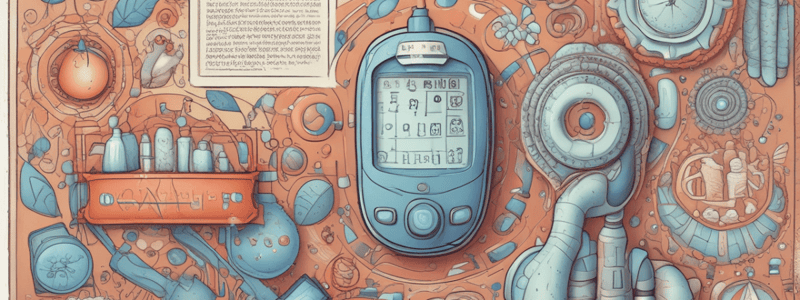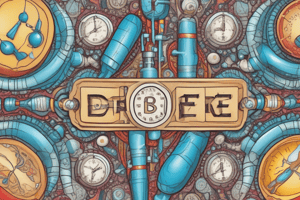Podcast
Questions and Answers
What is the primary cause of chronic hyperglycaemia in diabetes mellitus?
What is the primary cause of chronic hyperglycaemia in diabetes mellitus?
- Relative or absolute insulin deficiency (correct)
- Environmental factors such as viruses and chemicals
- Genetic predisposition
- Abnormalities of insulin receptors
Which type of diabetes is characterized by an absolute need for insulin therapy?
Which type of diabetes is characterized by an absolute need for insulin therapy?
- Gestational diabetes
- Type II diabetes
- Malnutrition-related diabetes
- Type I diabetes (correct)
What is the primary function of glucagon in the body?
What is the primary function of glucagon in the body?
- To raise blood glucose levels (correct)
- To stimulate insulin production
- To lower blood glucose levels
- To facilitate glucose entry into cells
What complication of diabetes is associated with disordered metabolism?
What complication of diabetes is associated with disordered metabolism?
Which type of diabetes is characterized by a heterogeneous disorder with a multifactorial inheritance?
Which type of diabetes is characterized by a heterogeneous disorder with a multifactorial inheritance?
What is the effect of insulin on glucose metabolism?
What is the effect of insulin on glucose metabolism?
What is the primary complication of untreated diabetes?
What is the primary complication of untreated diabetes?
What is the effect of sulfonylureas on insulin production?
What is the effect of sulfonylureas on insulin production?
What is the primary cause of insulin resistance in Type II diabetes?
What is the primary cause of insulin resistance in Type II diabetes?
What is the effect of metformin on glucose metabolism?
What is the effect of metformin on glucose metabolism?
What is the primary consequence of reduced tissue sensitivity to insulin?
What is the primary consequence of reduced tissue sensitivity to insulin?
Which of the following is a complication of diabetes that is associated with a 15% mortality rate?
Which of the following is a complication of diabetes that is associated with a 15% mortality rate?
What is the primary mechanism by which hyperglycemia contributes to diabetic complications?
What is the primary mechanism by which hyperglycemia contributes to diabetic complications?
What is the primary consequence of impaired insulin secretion in diabetes?
What is the primary consequence of impaired insulin secretion in diabetes?
Which of the following is a risk factor for developing ketoacidosis?
Which of the following is a risk factor for developing ketoacidosis?
What is the primary mechanism by which insulin receptor signaling is inhibited in diabetes?
What is the primary mechanism by which insulin receptor signaling is inhibited in diabetes?
What is the primary consequence of protein glycosylation in diabetes?
What is the primary consequence of protein glycosylation in diabetes?
Which of the following is a symptom of hypoglycemia?
Which of the following is a symptom of hypoglycemia?
What is the primary complication of diabetic nephropathy?
What is the primary complication of diabetic nephropathy?
Which of the following is a characteristic of diabetic neuropathy?
Which of the following is a characteristic of diabetic neuropathy?
What is the primary cause of diabetic retinopathy?
What is the primary cause of diabetic retinopathy?
Which of the following is a complication of diabetic macrovascular disease?
Which of the following is a complication of diabetic macrovascular disease?
What is the primary feature of diabetic cardiomyopathy?
What is the primary feature of diabetic cardiomyopathy?
Which of the following is a complication of diabetic microvascular disease?
Which of the following is a complication of diabetic microvascular disease?
What is the primary cause of diabetic foot ulcers?
What is the primary cause of diabetic foot ulcers?
Which of the following is a characteristic of diabetic glomerulosclerosis?
Which of the following is a characteristic of diabetic glomerulosclerosis?
What is the primary complication of diabetic macrovascular disease?
What is the primary complication of diabetic macrovascular disease?
Which of the following is a feature of proliferative diabetic retinopathy?
Which of the following is a feature of proliferative diabetic retinopathy?
Flashcards are hidden until you start studying
Study Notes
Diabetes Mellitus: Definition and Overview
- Diabetes mellitus is a group of metabolic disorders characterized by chronic hyperglycemia, which is a high blood sugar level, and disordered metabolism. This condition is associated with major vascular complications, such as heart disease and stroke, and specific microvascular complications, including diabetic retinopathy and nephropathy. Diabetes mellitus affects approximately 422 million people worldwide, making it a significant public health burden.
- The term "diabetes" comes from the Greek word "diabetes", meaning "to run through" or "a siphon", and "mellitus" comes from the Latin word "honey", referring to the sweet urine associated with the condition. The Greek physician Aretaeus of Cappadocia is credited with coining the term "diabetes" in the 2nd century AD. The term "mellitus" was later added to distinguish the condition from other types of diabetes.
Insulin and Glucagon
- Insulin is a hormone produced by beta cells in the islet of Langerhans, a region of the pancreas. Insulin regulates glucose entry into cells, promoting glucose uptake and storage in the liver, muscles, and adipose tissue. Insulin also inhibits glucose production in the liver and promotes the storage of glucose in the form of glycogen.
- Glucagon, on the other hand, is a hormone produced by alpha cells in the islet of Langerhans. Glucagon raises blood glucose levels by stimulating the breakdown of glycogen to glucose in the liver and promoting glucose release from the liver into the bloodstream. Glucagon has an antagonistic effect to insulin, meaning that it counteracts the glucose-lowering effects of insulin.
- Insulin and glucagon work together to maintain normal blood glucose levels. When blood glucose levels rise after a meal, insulin is released to promote glucose uptake and storage. Conversely, when blood glucose levels fall, glucagon is released to stimulate glucose release from the liver and promote glucose production. This delicate balance between insulin and glucagon is crucial for maintaining normal blood glucose levels and preventing the development of diabetes.
Classification of Diabetes
- Insulin-dependent diabetes mellitus (IDDM) or type I diabetes is a chronic autoimmune disease characterized by an absolute need for insulin therapy. In IDDM, the immune system mistakenly attacks and destroys the beta cells in the pancreas, resulting in a complete deficiency of insulin production. As a result, individuals with IDDM require insulin injections to control their blood glucose levels.
- Non-insulin-dependent diabetes mellitus (NIDDM) or type II diabetes is the most common form of diabetes, accounting for approximately 90% of all diabetes cases. NIDDM is characterized by insulin resistance, a condition in which the body's cells become resistant to the effects of insulin, leading to impaired glucose uptake and storage. Additionally, NIDDM may also involve impaired insulin secretion, leading to a decrease in insulin production. NIDDM can often be managed through dietary changes, weight loss, and exercise, although oral hypoglycemic agents may be necessary in some cases.
- Other types of diabetes include gestational diabetes, which develops during pregnancy, and malnutrition-related diabetes, which occurs in individuals with severe protein-energy malnutrition. Maturity-onset diabetes of the young (MODY) is a rare form of diabetes that occurs in young adults and is characterized by impaired insulin secretion and a strong family history of diabetes. Secondary diabetes, on the other hand, develops as a complication of another medical condition, such as pancreatic disease or hormonal disorders.
Pathogenesis and Treatment of IDDM and NIDDM
-
IDDM is characterized by a genetic predisposition, autoimmune destruction of beta cells, environmental factors, and insulin injections. The exact causes of IDDM are still not fully understood, but it is believed that genetic and environmental factors, such as viral infections, may trigger the autoimmune response that leads to beta cell destruction. Treatment of IDDM involves insulin injections, which must be administered multiple times a day to control blood glucose levels.
-
NIDDM, on the other hand, is characterized by multifactorial inheritance, reduced response to insulin, and dietary management, with oral hyp
-
.
Studying That Suits You
Use AI to generate personalized quizzes and flashcards to suit your learning preferences.




